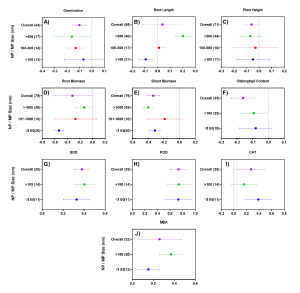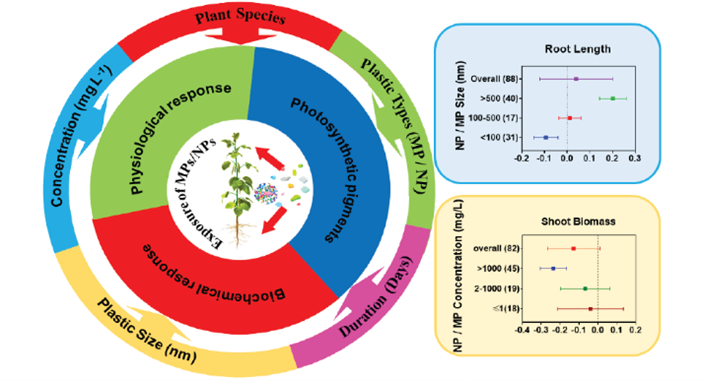Plastic contamination has become a widespread societal and ecological threat due to its global application, persistence, and adverse impact on biota. Global plastic production has reached 368 million tons, with production in China and Europe at 114.08 and 58.88 million tons in 2019, respectively; some predictions of global production to exceed 33 billion tons by 2050.
Soil systems have become a major sink of plastics due to agricultural activities, including through amendments of sewage/sludge and organic fertilizers, as well as through the use of plastic films and mulches. Specifically, the application of municipal sludge in agriculture adds approximately 7.76 million tons of synthetic fibers or sedimented MPx NPx to soil systems each year. Furthermore, mulching use for crop production as part of weed control and irrigation strategies introduces approximately 4.4 million tons of plastics each year to soils. In addition, landfill sites have been identified as one of the most significant entry pathways of plastic pollution into the environment.
Given the known and expected discharge of plastics into the environment, we conducted a meta-analysis using the published literature on effects of MPx/NPx on agricultural plant species.
Problems
Plastic’s diverse effects (MPx and NPx) decreased the development of plant species in distinct ways and their size has a substantial detrimental impact on plant physiological, photosynthetic and biochemical responses.
Main findings
Plastic disturb the different plant species growth
Physiological response: In our analysis the plant germination, plant height, and shoot biomass were reduced 6%, 8%, and 9% respectively upon exposure to MPx/NPx, whereas root length and root biomass each were non-significantly increased by 3%.
Photosynthetic pigments: The endpoint of photosynthetic pigments shows different responses upon exposure to MPx/NPx. Photosynthetic rate, total chlorophyll content and chlorophyll b were reduced by 10%, 8% and 6%, respectively, whereas chlorophyll a was unaffected by exposure.
Biochemical response: The biochemical response of plant species was consistently increased with MPx/NPx exposure; specifically, peroxidase (POD) was increased 74%, superoxide dismutase (SOD) by 56%, catalase (CAT) by 27%, and malonaldehyde (MDA) (n=32) by 29%.

Figure. Ecotoxicological effects of MPx/NPx on plant species. The circle shows the number of endpoints and the color indicates the effect on the plant.
Effects of MPx/NPx size on plants
Depending on endpoints, smaller size plastic particles (i.e., <5 µm) are generally assumed to be more toxic as compared to larger size materials. A negative response on plant germination resulted from exposure to MPx/NPx and this response varied with size. With MPx/NPx sizes of <100 nm, 100-400 nm and >400 nm, germination decreased by 7%, 19% and 27%, respectively. Small plastic size particles (<100 nm) significantly decreased (9%) the root length, while large size plastic particles (>500 nm) have shown a positive effect (22%) on root elongation. For plant height, MPx/NPx sizes of <100 nm, 100-400 nm, and >400 nm showed non-significant effects.
MPx/NPx size exerted generally negative impacts on root biomass. For example, root biomass was significantly reduced by 41% with ≤100 nm size particles, followed by 24% in 101-1000 nm and 12% with MPx of >1000 nm. Shoot biomass showed a similar negative response under various sizes of MPx/NPx particles. Significant negative reductions (27%) in shoot mass were observed at <100 nm, followed by 17% at 101-1000 nm, and 34% at >1000 nm. Total chlorophyll content showed generally non-significant effects from exposure to MPx/NPx, with reductions of 8% at ≤100 and 9% at >100 nm.
Plant SOD activity was significantly affected by NPx/MPx as a function of size, as significant increases were observed at ≤100 nm (36%) and at >100 nm (50%) size. Plant POD activity was also increased with MPx/NPx size, including 108% at ≤100 and 109% at >100 nm particle size. Additionally, CAT activity was increased by 48% upon exposure of ≤100 nm and 17% increase was observed with particles of >100 nm. A similar trend was observed with MDA activity; specifically, <100 nm increased values by 17% and under >100 nm the increase was 44%.

Figure 4. Mean effect of plastics size on germination (A), root length (B), plant height (C), root biomass (D), shoot biomass (E), total chlorophyll content (F), SOD (G), POD (H), CAT (I) and MDA (J). Sample size is noted on the left side bars.
Way forward
MPx of various forms and polymers have a deleterious impact on soil characteristics and microbial activity. In the long run, additional variables may come into play, amplifying the detrimental impacts. We also know very little about the breakdown of microplastics, which may release harmful elements into the soil system. Plastic-derived toxic compounds may alter soil structure and microbial populations, as well as the symbiotic interaction between soil-borne bacteria and plants.
Reference
Azeem, I., Adeel, M†*., et al. (2022). Micro and Nanoplastics Interactions with Plant Species: Trends, Meta-Analysis, and Perspectives. Environmental Science & Technology Letters. https://doi.org/10.1021/acs.estlett.2c00107


